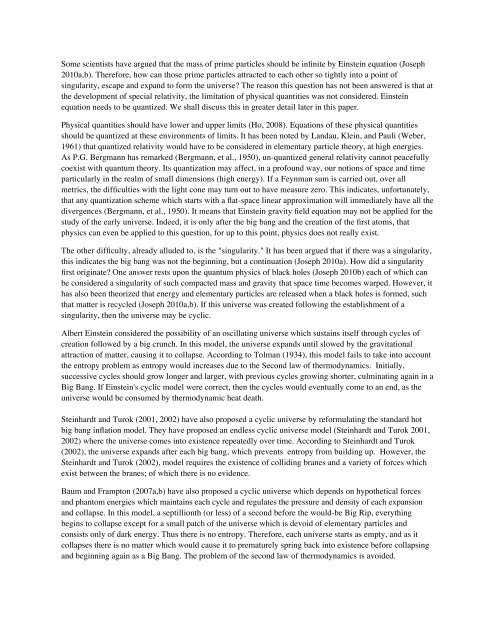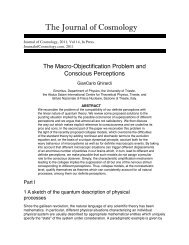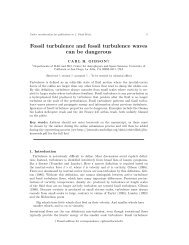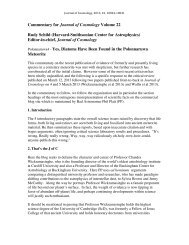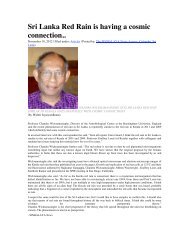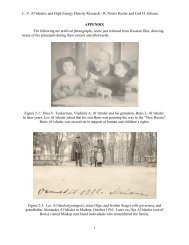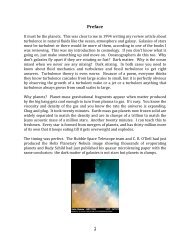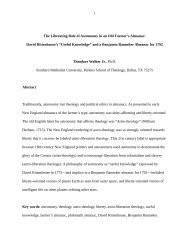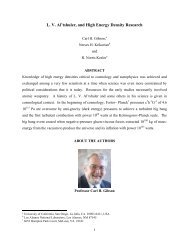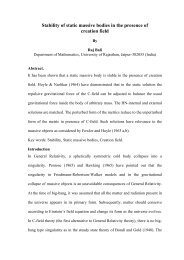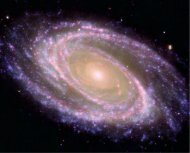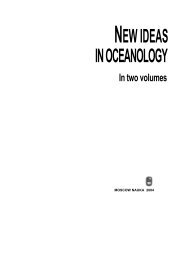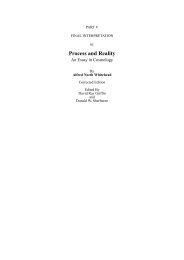The Quantization of Classical Fields Equations and the Cyclic ...
The Quantization of Classical Fields Equations and the Cyclic ...
The Quantization of Classical Fields Equations and the Cyclic ...
Create successful ePaper yourself
Turn your PDF publications into a flip-book with our unique Google optimized e-Paper software.
Some scientists have argued that <strong>the</strong> mass <strong>of</strong> prime particles should be infinite by Einstein equation (Joseph<br />
2010a,b). <strong>The</strong>refore, how can those prime particles attracted to each o<strong>the</strong>r so tightly into a point <strong>of</strong><br />
singularity, escape <strong>and</strong> exp<strong>and</strong> to form <strong>the</strong> universe? <strong>The</strong> reason this question has not been answered is that at<br />
<strong>the</strong> development <strong>of</strong> special relativity, <strong>the</strong> limitation <strong>of</strong> physical quantities was not considered. Einstein<br />
equation needs to be quantized. We shall discuss this in greater detail later in this paper.<br />
Physical quantities should have lower <strong>and</strong> upper limits (Ho, 2008). <strong>Equations</strong> <strong>of</strong> <strong>the</strong>se physical quantities<br />
should be quantized at <strong>the</strong>se environments <strong>of</strong> limits. It has been noted by L<strong>and</strong>au, Klein, <strong>and</strong> Pauli (Weber,<br />
1961) that quantized relativity would have to be considered in elementary particle <strong>the</strong>ory, at high energies.<br />
As P.G. Bergmann has remarked (Bergmann, et al., 1950), un-quantized general relativity cannot peacefully<br />
coexist with quantum <strong>the</strong>ory. Its quantization may affect, in a pr<strong>of</strong>ound way, our notions <strong>of</strong> space <strong>and</strong> time<br />
particularly in <strong>the</strong> realm <strong>of</strong> small dimensions (high energy). If a Feynman sum is carried out, over all<br />
metrics, <strong>the</strong> difficulties with <strong>the</strong> light cone may turn out to have measure zero. This indicates, unfortunately,<br />
that any quantization scheme which starts with a flat-space linear approximation will immediately have all <strong>the</strong><br />
divergences (Bergmann, et al., 1950). It means that Einstein gravity field equation may not be applied for <strong>the</strong><br />
study <strong>of</strong> <strong>the</strong> early universe. Indeed, it is only after <strong>the</strong> big bang <strong>and</strong> <strong>the</strong> creation <strong>of</strong> <strong>the</strong> first atoms, that<br />
physics can even be applied to this question, for up to this point, physics does not really exist.<br />
<strong>The</strong> o<strong>the</strong>r difficulty, already alluded to, is <strong>the</strong> "singularity." It has been argued that if <strong>the</strong>re was a singularity,<br />
this indicates <strong>the</strong> big bang was not <strong>the</strong> beginning, but a continuation (Joseph 2010a). How did a singularity<br />
first originate? One answer rests upon <strong>the</strong> quantum physics <strong>of</strong> black holes (Joseph 2010b) each <strong>of</strong> which can<br />
be considered a singularity <strong>of</strong> such compacted mass <strong>and</strong> gravity that space time becomes warped. However, it<br />
has also been <strong>the</strong>orized that energy <strong>and</strong> elementary particles are released when a black holes is formed, such<br />
that matter is recycled (Joseph 2010a,b). If this universe was created following <strong>the</strong> establishment <strong>of</strong> a<br />
singularity, <strong>the</strong>n <strong>the</strong> universe may be cyclic.<br />
Albert Einstein considered <strong>the</strong> possibility <strong>of</strong> an oscillating universe which sustains itself through cycles <strong>of</strong><br />
creation followed by a big crunch. In this model, <strong>the</strong> universe exp<strong>and</strong>s until slowed by <strong>the</strong> gravitational<br />
attraction <strong>of</strong> matter, causing it to collapse. According to Tolman (1934), this model fails to take into account<br />
<strong>the</strong> entropy problem as entropy would increases due to <strong>the</strong> Second law <strong>of</strong> <strong>the</strong>rmodynamics. Initially,<br />
successive cycles should grow longer <strong>and</strong> larger, with previous cycles growing shorter, culminating again in a<br />
Big Bang. If Einstein's cyclic model were correct, <strong>the</strong>n <strong>the</strong> cycles would eventually come to an end, as <strong>the</strong><br />
universe would be consumed by <strong>the</strong>rmodynamic heat death.<br />
Steinhardt <strong>and</strong> Turok (2001, 2002) have also proposed a cyclic universe by reformulating <strong>the</strong> st<strong>and</strong>ard hot<br />
big bang inflation model. <strong>The</strong>y have proposed an endless cyclic universe model (Steinhardt <strong>and</strong> Turok 2001,<br />
2002) where <strong>the</strong> universe comes into existence repeatedly over time. According to Steinhardt <strong>and</strong> Turok<br />
(2002), <strong>the</strong> universe exp<strong>and</strong>s after each big bang, which prevents entropy from building up. However, <strong>the</strong><br />
Steinhardt <strong>and</strong> Turok (2002), model requires <strong>the</strong> existence <strong>of</strong> colliding branes <strong>and</strong> a variety <strong>of</strong> forces which<br />
exist between <strong>the</strong> branes; <strong>of</strong> which <strong>the</strong>re is no evidence.<br />
Baum <strong>and</strong> Frampton (2007a,b) have also proposed a cyclic universe which depends on hypo<strong>the</strong>tical forces<br />
<strong>and</strong> phantom energies which maintains each cycle <strong>and</strong> regulates <strong>the</strong> pressure <strong>and</strong> density <strong>of</strong> each expansion<br />
<strong>and</strong> collapse. In this model, a septillionth (or less) <strong>of</strong> a second before <strong>the</strong> would-be Big Rip, everything<br />
begins to collapse except for a small patch <strong>of</strong> <strong>the</strong> universe which is devoid <strong>of</strong> elementary particles <strong>and</strong><br />
consists only <strong>of</strong> dark energy. Thus <strong>the</strong>re is no entropy. <strong>The</strong>refore, each universe starts as empty, <strong>and</strong> as it<br />
collapses <strong>the</strong>re is no matter which would cause it to prematurely spring back into existence before collapsing<br />
<strong>and</strong> beginning again as a Big Bang. <strong>The</strong> problem <strong>of</strong> <strong>the</strong> second law <strong>of</strong> <strong>the</strong>rmodynamics is avoided.


